Charles E W Bean, Diaries, AWM38 3DRL 606/271/1 - 1917 - 1938 - Part 8
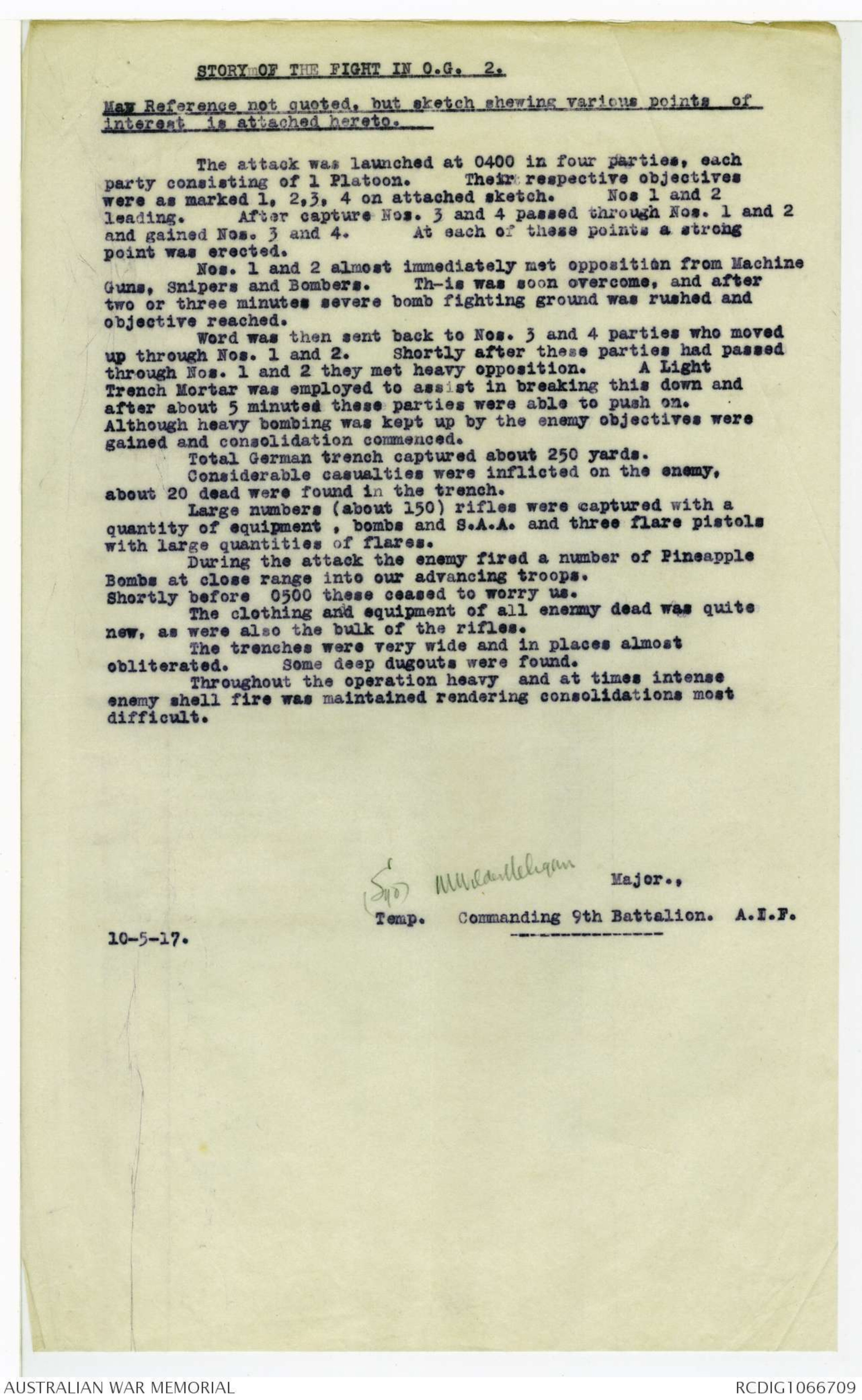
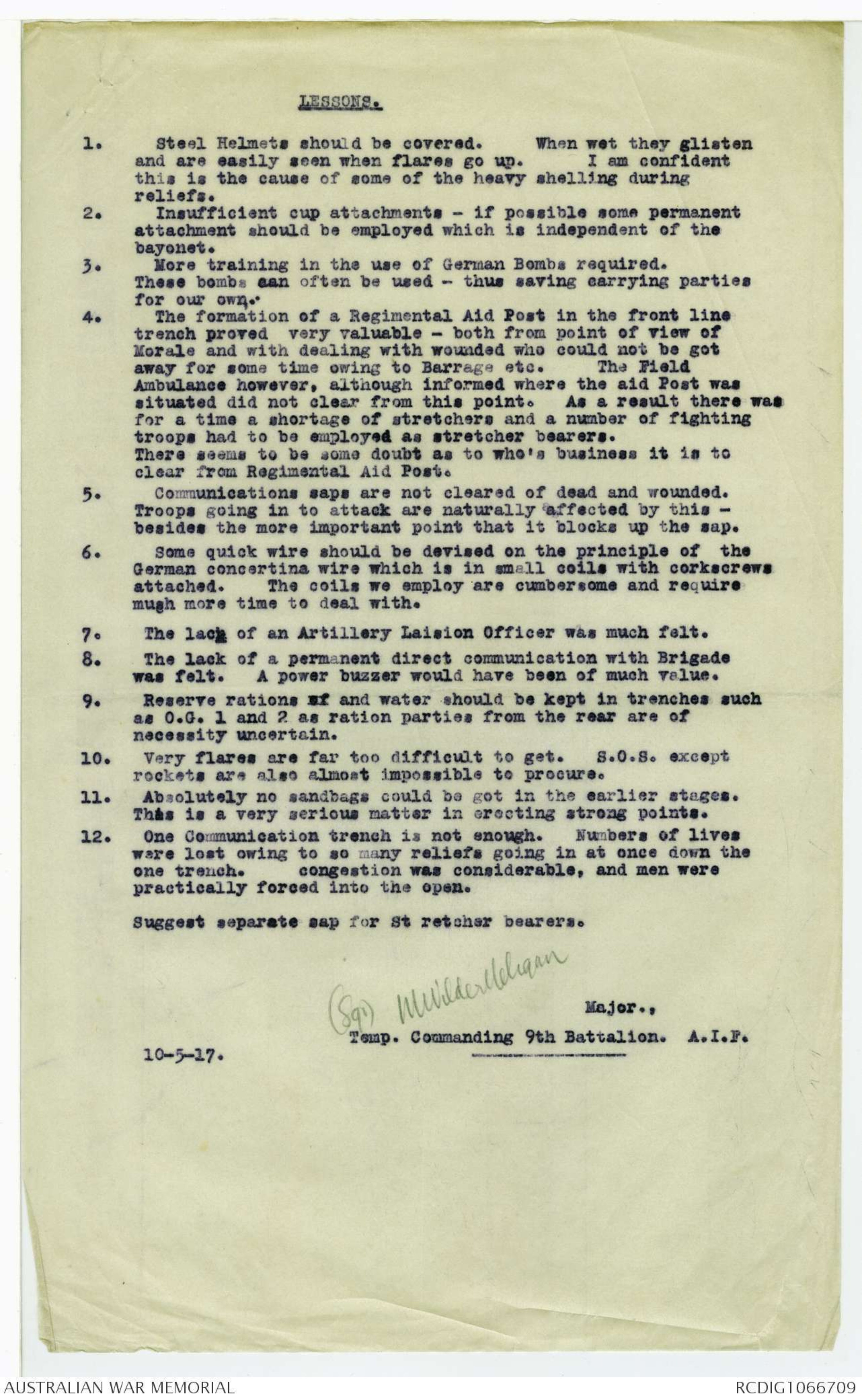

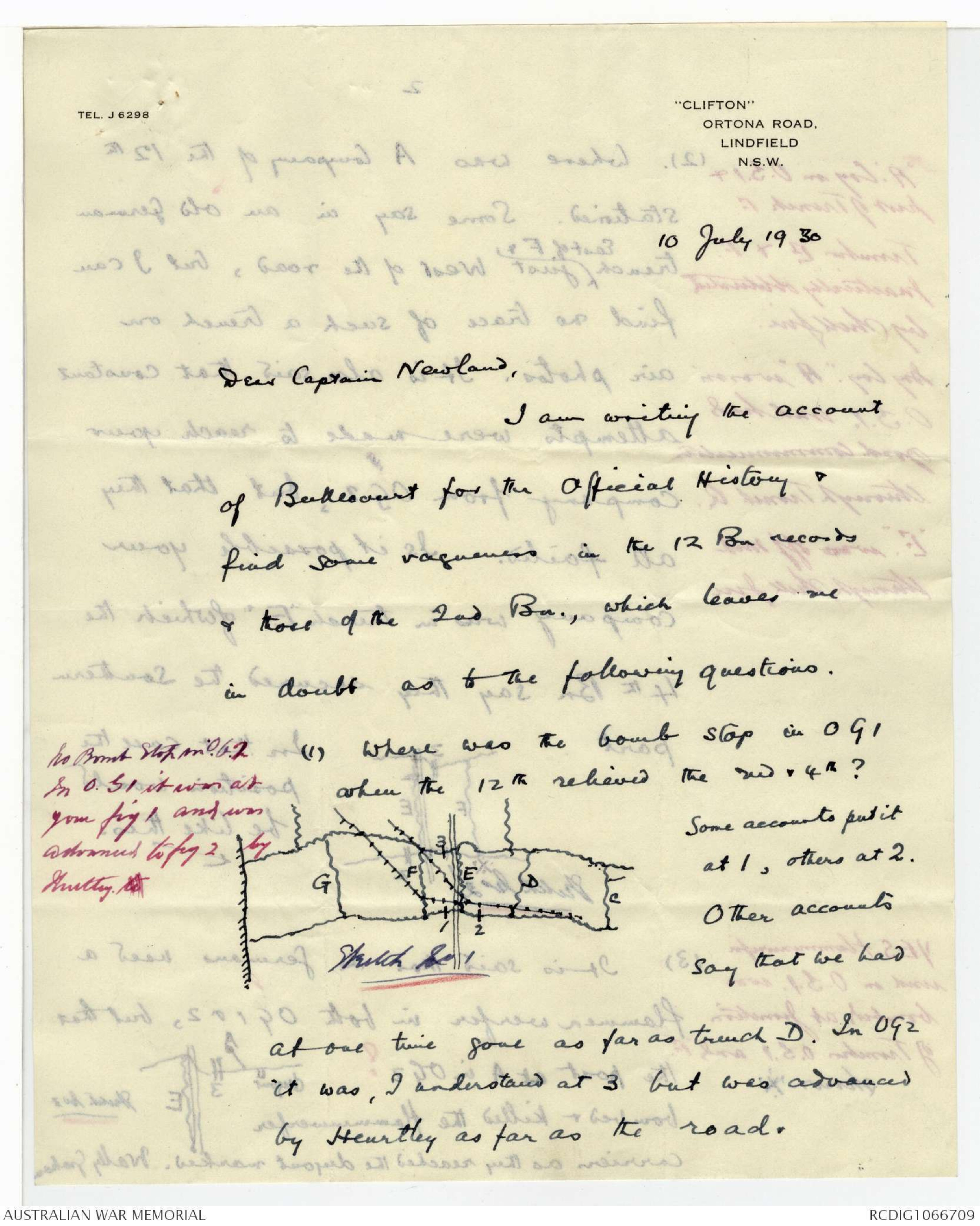
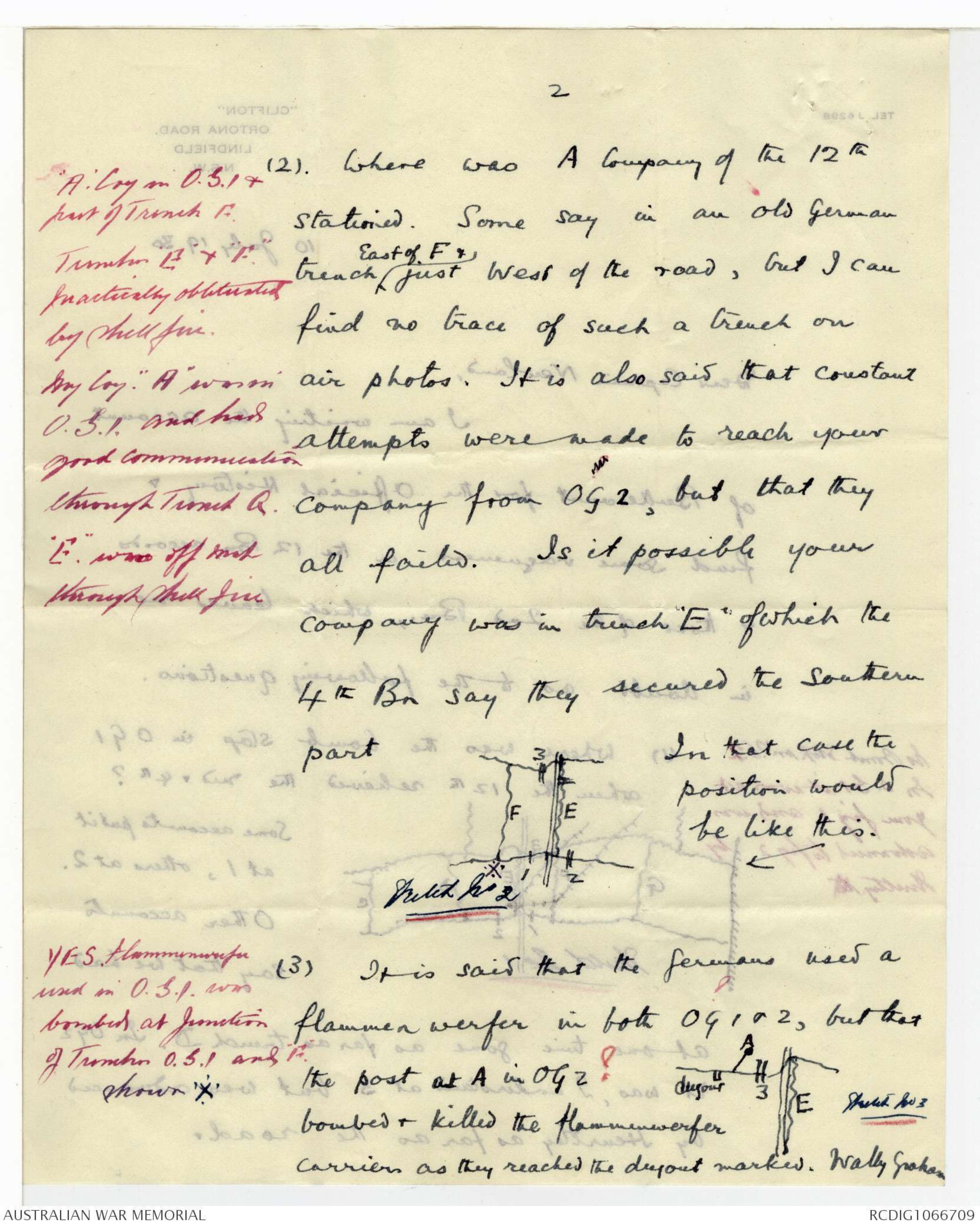

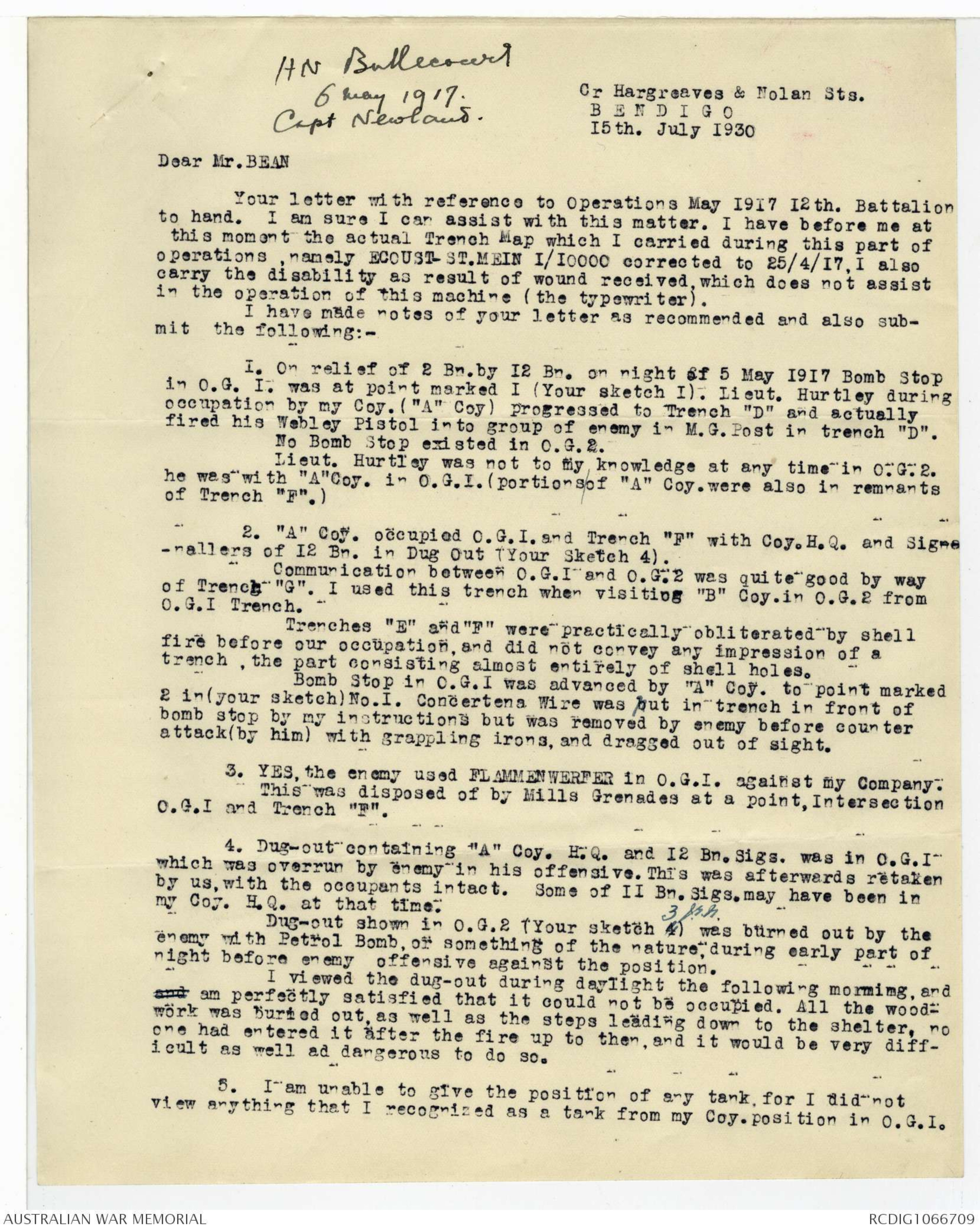
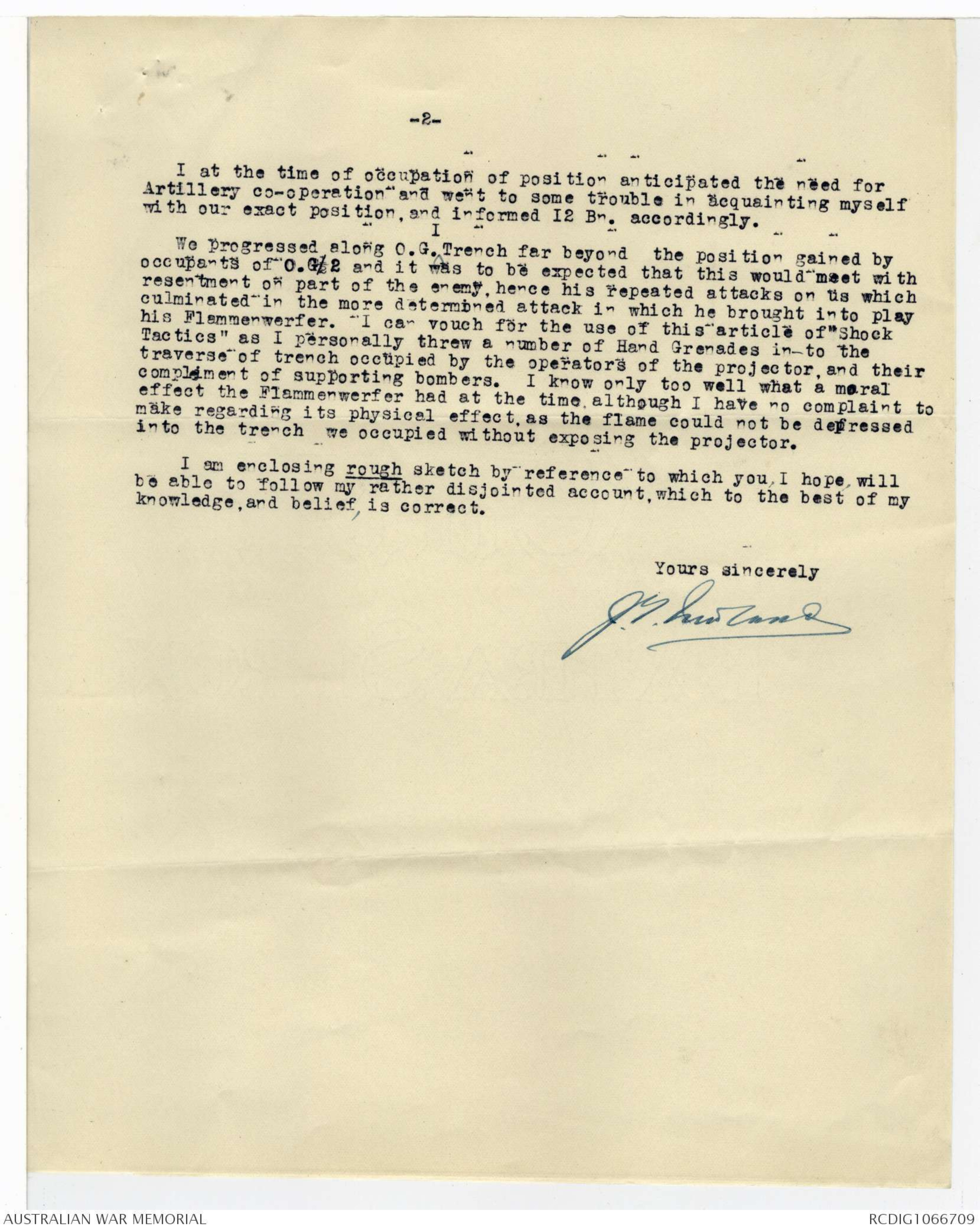
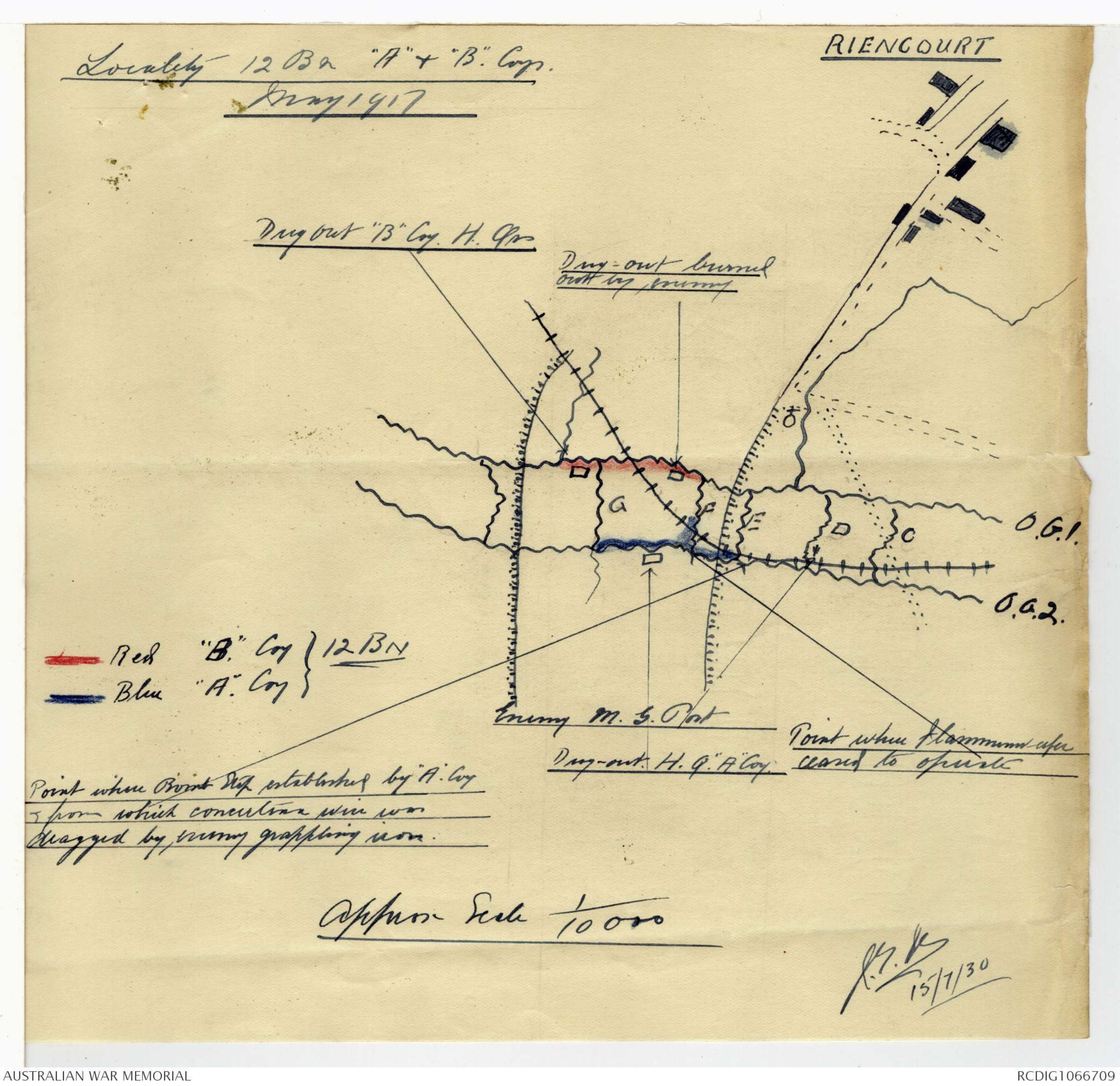
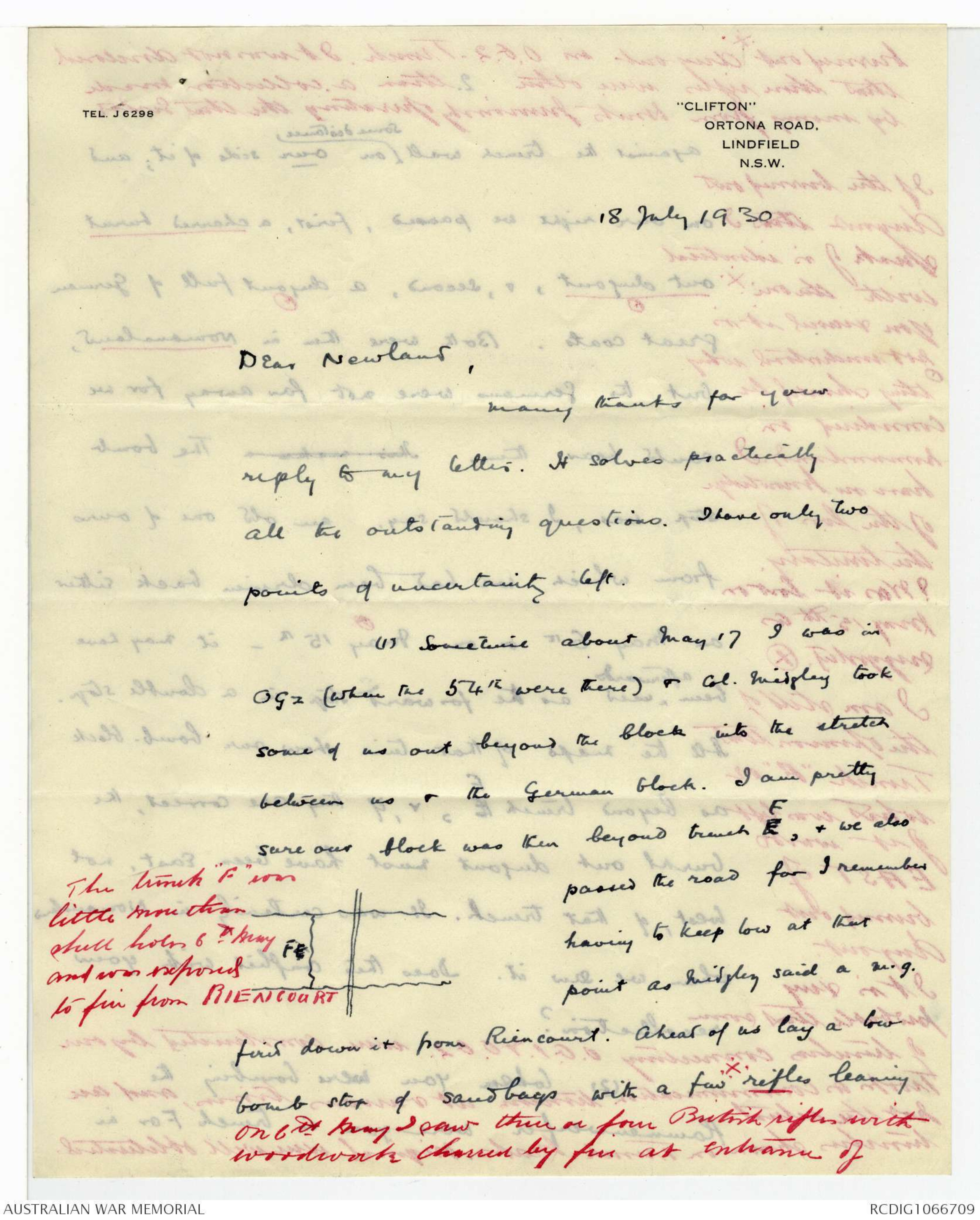
STORY OF THE FIGHT IN O.G. 2.
Map References not quoted, but sketch shewing various points of
interest Is attached hereto.
The attack was launched at 0400 in four parties, each
party consisting of 1 Platoon. Their respective objectives
were as marked 1, 2, 3, 4 on attached sketch. Nos 1 and 2
leading. After capture Nos. 3 and 4 passed through Nos. 1 and 2
and gained Nos. 3 and 4. At each of these points a strong
point was erected.
Nos. 1 and 2 almost immediately met opposition from Machine
Guns, Snipers and Bombers. Th-is was soon overcome, and after
two or three minutes severe bomb fighting ground was rushed and
objective reached.
Word was then sent back to Nos. 3 and 4 parties who moved
up through Nos. 1 and 2. Shortly after these parties had passed
through Nos. 1 and 2 they met heavy opposition. A Light
Trench Mortar was employed to assist in breaking this down and
after about 5 minutes these parties were able to push on.
Although heavy bombing was kept up by the enemy objectives were
gained and consolidation commenced.
Total German trench captured about 250 yards.
Considerable casualties were inflicted on the enemy,
about 20 dead were found in the trench.
Large numbers (about 150) rifles were captured with a
quantity of equipment, bombs and S.A.A. and three flare pistols
with large quantities of flares.
During the attack the enemy fired a number of Pineapple
Bombs at close range into our advancing troops.
Shortly before 0500 these ceased to worry us.
The clothing and equipment of all enemy dead was quite
new, as were also the bulk of the rifles.
The trenches were very wide and in places almost
obliterated. Some deep dugouts were found.
Throughout the operation heavy and at times intense
enemy shell fire was maintained rendering consolidations most
difficult.
(Sgd) M Wilder-Neligan
Major.,
Temp. Commanding 9th Battalion. A.I.F.
10-5-17.
LESSONS
1. Steel helmets should be covered. When wet they glisten
and are easily seen when flares go up. I am confident
this is the cause of some of the heavy shelling during
reliefs.
2. Insufficient cup attachments - if possible some permanent
attachment should be employed which is independent of the
bayonet.
3. More training in the use of German Bombs required.
These bombs can often be used - thus saving carrying parties
for our own.
4. The formation of a Regimental Aid Post in the front line
trench proved very valuable - both from point of view of
Morale and with dealing with wounded who could not be got
away for some time owing to Barrage etc. The Field
Ambulance however, although informed where the aid Post was
situated did not clear from this point. As a result there was
for a time a shortage of stretchers and a number of fighting
troops had to be employed as stretcher bearers.
There seems to be some doubt as to who's business it is to
clear from Regimental Aid Post.
5. Communications saps are not cleared of dead and wounded.
Troops going in to attack are naturally affected by this -
besides the more important point that it blocks up the sap.
6. Some quick wire should be devised on the principle of the
German concertina wire which is in small coils with corkscrews
attached. The coils we employ are cumbersome and require
much more time to deal with.
7. The lack of an Artillery Laision Officer was much felt.
8. The lack of a permanent direct communication with Brigade
was felt. A power buzzer would have been of much value.
9. Reserve rations of and water should be kept in trenches such
as O.G. 1 and 2 as ration parties from the rear are of
necessity uncertain.
10. Very flares are far too difficult to get. S.O.S. except
rockets are also almost impossible to procure.
11. Absolutely no sandbags could be got in the earlier stages.
This is a very serious matter in erecting strong points.
12. One Communication trench is not enough. Numbers of lives
were lost owing to so many reliefs going in at once down the
one trench. congestion was considerable, and men were
practically forced into the open.
Suggest separate sap for stretcher bearers.
(Sgd) M Wilder-Neligan
Major.,
Temp. Commanding 9th Battalion. A.I.F.
10-5-17.
1:10,000
ECOUST-ST MEIN
[*(3rd Bde*]
fighting)
EDITION 3.
Map - see original document
TEL J 6298
'CLIFTON"
ORTONA ROAD.
LINDFIELD
N.S.W.
10 July 19 30
Dear Captain Newland
I am writing the account
of Bullecourt for the Official History &
find some vagueness in the 12 Bn records
& those of the 2nd. Bn., which leaves me
in doubt as to the following questions.
(1) Where was the bomb stop in OG1
when the 12th relieved the 2nd & 4th?
Diagram - see original document
Some accounts put it
at 1, others at 2.
Other accounts
say that we had
at one time gone as far as trench D. In OG2
it was, I understand at 3, but was advanced
by Heurtley as far as the road.
[*No bomb stop in OG2
In OG1 it was at
your fig 1 and was
advanced to fig 2 by
Hurtley to*]
2
(2). Where was A company of the 12th
stationed. Some say in an old German
trench ^ East of F & just West of the road, but I can
find no trace of such a trench on
air photos. It is also said that constant
attempts were made to reach your
company from OG2 but that they
all failed. Is it possible your
company was in trench "E" of which the
4th Bn say they secured the Southern
part
Diagram - see original document
In that case the
position would
be like this.
←
(3) It is said that the Germans used a
flammenwerfer in both OG1 & 2, but that
the post at A in OG2 shown ':X:'
bombed & killed the flammenwerfer
carriers as they reached the dugout marked. Wally Graham
[*"A". Coy in O.G.1 &
part of Trench F.
Trenches E & F
practically obliterated
by shell fire.
My Coy. "A" was in
O.G.1 and had
good communication
through Trench Q.
"E." was off map
through shell fire*]
[*YES. flammenwerfer
used in O.G.1 was
bombed at Junction
of Trenches O.G.1 & "F"
shown ※*]
3
TEL. J6298
"CLIFTON"
ORTONA ROAD
LINDFIELD
N.S.W.
[*※ I was [[?]] well wounded at the latter phase
of this operation and still have as the result
"Very vivid recollection" of the happenings.*]
of the 11th told me this & said that the burnt body of
the carrier & his apparatus were lying there
afterwards. Can you confirm or comment on
this?
[*Graham probably bn misquoted O.G.2 for
O.G.1. I take O.G.1 as the Enemys most
forward trench.*]
(4) Some signallers of the 12th were overrun
in their dugout, & stayed there till it was
retaken. The same thing is related of some
signallers of the 11th at the point marked
X below. Can you say whether this is
another version of the same story or a
separate incident (Graham told me of
the 11 Bn Sigs),
[* I have no doubt that 11 Bn Sigs
were at the time at my Coy.
H.Qrs. in O.G.1 (one). I have
some slight recollection of
seeing Graham in my trench.
I personally saw very little
of inside of dugout.*]
Diagram - see original document
(5) Do you remember the precise position of the old tank in the German lines?
If you could just make notes ^of your answers on this
paper & return it to me I should be grateful -
Also any recollection you have of the [*※*]
incident. I believe you and Foster rallied the troops
at the road. xxxxxx
[*I saw nothing
resembling a tank
from my position.*]
The chapter is now being written and I should therefore be
grateful for an answer as soon as is convenient.
With kind regards, Yours sincerely
C.E.W. Bean
[*H N Bullecourt
6 May 1917.
Capt Newland.*]
Cr Hargreaves & Nolan Sts.
BENDIGO
15th. July 1930
Dear Mr.BEAN
Your letter with reference to Operations May 1917 12th. Battalion
to hand. I am sure I can assist with this matter. I have before me at
this moment the actual Trench Map which I carried during this part of
operations, namely ECOUSE-ST.MEIN 1/10000 corrected to 25/4/17, I also
carry the disability as result of wound received, which does not assist
in the operation of this machine (the typewriter),
I have made notes of your letter as recommended and also submit
the following:-
1. On relief of 2 Bn. by 12 Bn. on night of 5 May 1917 Bomb Stop
in O.G.I. was at point marked I (Your sketch I): Lieut. Hurtley during
occupation by my Coy. ("A" Coy) progressed to Trench "D" and actually
fired his Webley Pistol into group of enemy in M.G. Post in trench "D",
No Bomb Stop existed in O.G.2.
Lieut. Hurtley was not to my knowledge at any time in O.G.2.
he was with "A" Coy. in O.G.1. (portions/of "A" Coy. were also in remnants
of Trench "F".)
2. "A" Coy. occupied O.G.1. and Trench "F" with Coy. H.Q. and
Signallers of 12 Bn. in Dug Out (Your Sketch 4).
Communication between O.G.1 and O.G.2 was quite good by way
of Trench "G". I used this trench when visiting "B" Coy. in O.G.2 from
O.G.1 Trench.
Trenches "E" and "F" were practically obliterated by shell
fire before our occupation, and did not convey any impression of a
trench, the part consisting almost entirely of shell holes.
Bomb Stop in O.G.1 was advanced by "A" Coy. to point marked
2 in (your sketch) No.1. Concertena Wire was bput in trench in front of
bomb stop by my instructions but was removed by enemy before counter
attack (by him) with grappling irons, and dragged out of sight.
3. YES, the enemy used FLAMMENWERFER in O.G.1. against my Company.
This was disposed of by Mills Grenades at a point, Intersection
O.G.1 and Trench "F".
4. Dug-out containing "A" Coy. H.Q. and 12 Bn. Sigs. was in O.G.1
which was overrun by enemy in his offensive. This was afterwards retaken
by us, with the occupants intact. Some of 11 Bn. Sigs. may have been in
my Coy. H.Q. at that time.
Dug-out shown in O.G.2 (Your sketch 4^3 j.g.n.) was burned out by the
enemy with Petrol Bomb, of something of the nature, during early part of
night before enemy offensive against the position.
I viewed the dug-out during daylight the following morning, andand am perfectly satisfied that it could not be occupied. All the woodwork
was burned out, as well as the steps leading down to the shelter, no
one had entered it after the fire up to then, and it would be very diffcult
as well as dangerous to do so.
5. I am unable to give the position of any tank, for I did not
view anything that I recognized as a tank from my Coy. position in O.G.1.
- 2 -
I at the time of occupation of position anticipated the need for
Artillery co-operation and went to some trouble in acquainting myself
with our exact position, and informed 12 Bn. accordingly.
We progressed along O.G.^1 Trench far beyond the position gained by
occupants of 0.G.½2 and it was to be expected that this would meet with
resentment of part of the enemy, hence his repeated attacks on us which
culminated in the more determined attack in which he brought into play
his Flammenwerfer. I can vouch for the use of this article of "Shock
Tactics" as I personally threw a number of Hand Grenades in-to the
traverse of trench occupied by the operators of the projector, and their
compliment of supporting bombers. I know only too well what a moral
effect the Flammenwerfer had at the time, although I have no complaint to
make regarding its physical effect, as the flame could not be depressed
into the trench we occupied without exposing the projector.
I am enclosing rough sketch by reference to which you, I hope, will
be able to follow my rather disjointed account, which to the best of my
knowledge, and belief, is correct.
Yours sincerely
J.G. Newland
RIENCOURT
Locality 12 Bn "A" & "B" Coys.
May 1917
Diagram - see original document
TEL J 6298
"CLIFTON"
ORTONA ROAD.
LINDFIELD
N.S.W.
18 July 19.30
Dear Newland,
Many thanks for your
reply to my letter. It solves practically
all the outstanding questions. I have only two
points of uncertainty. left
(1) Sometime about May 17 I was in
OG2 (when the 54th were there) & Col. Midgley took
some of us out beyond the block into the stretch
between us & the German block. I am pretty
sure our block was then beyond trench E F, & we also
passed the road for I remember
having to keep low at that
point as Midgley said a m.g
fired down it from Reincourt.
Diagram - see original document
[*The trench "F" was
little more than
shellholes 6th May
and was exposed
to fire from REINCOURT*]]
Ahead of us lay a low
bomb stop of sandbags with a few [*※*] rifles leaning
[*on 6th May I saw three or four British rifles with
woodwork charred by fire at entrance of*]
 Deb Parkinson
Deb ParkinsonThis transcription item is now locked to you for editing. To release the lock either Save your changes or Cancel.
This lock will be automatically released after 60 minutes of inactivity.